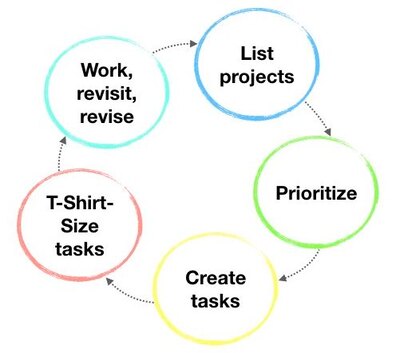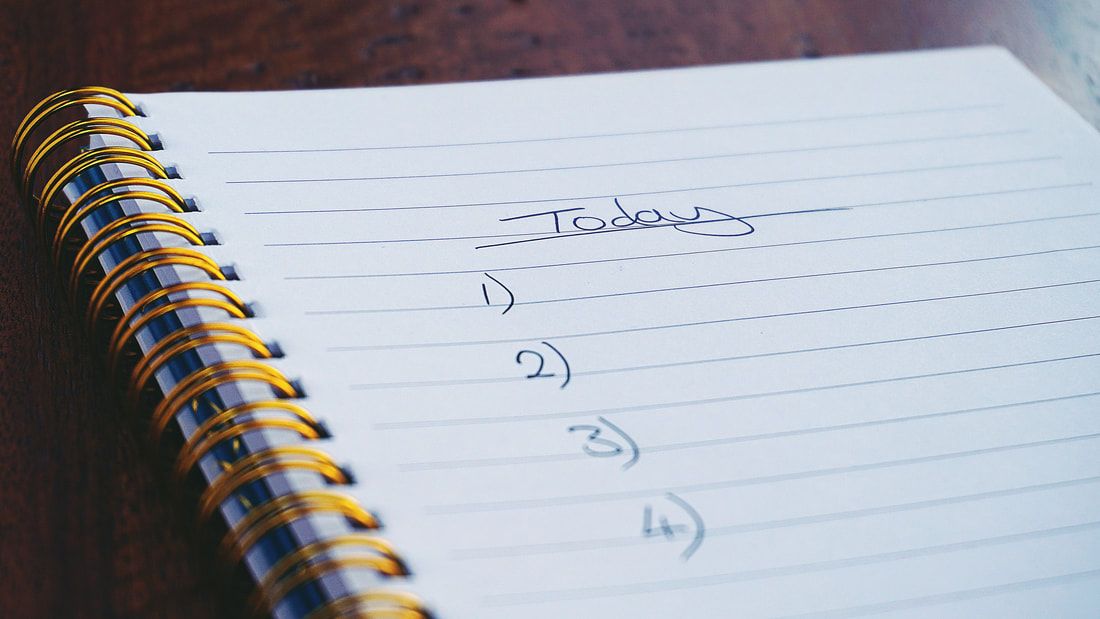|
Do you have an unwieldy, never-ending to-do list? My clients are often frustrated when things on their to-do lists aren’t getting done. They feel that they must be lacking in motivation or self-discipline. While it is possible that motivation or self-discipline can impact your productivity, more often than not, to-do lists become unwieldy because they contain large end outcomes (e.g., “write a book”) without clear, small immediate next steps (“draft a table of contents”). Honing your skills in a technique called T-Shirt-Sizing can help you to make your to-do lists less Herculean. One solution: T-Shirt-Sizing What do I mean by "T-Shirt-Sizing"? At Google, we used the term "T-Shirt-Sizing" as a metaphor for the process of estimating how much work each project or task will take. If a project seems like it might take multiple months, that’s a “Large.” If a project seems like it can get done in an afternoon, that’s a “Small”. T-Shirt-Sizing is a critical skill for making your to-do list...doable. How do I T-Shirt-Size? You can leverage T-Shirt-Sizing once you've identified and prioritized the list of projects that you need to work on. This technique enables you to create and size concrete next steps. I recommend asking yourself three questions to T-Shirt-Size while you’re making your daily to-do list:
How will T-Shirt-Sizing help me?
T-Shirt-Sizing will ensure that the tasks on your to-do list are small enough that they are possible to accomplish. This technique will break a behemoth, Large T-shirt project down into a set of Small T-shirt tasks that will make it easier for you to take action. Once you start taking action, you'll create a sense of momentum so that you feel proud of your progress instead of buried beneath a behemoth. Ideally, your Small tasks will be easily doable in 1 day and will have a clearly measurable result. Here are a few examples:
By practicing making Small tasks and checking how many you’re able to get done, you can revisit and revise your to-do lists until T-Shirt-Sizing serves you. Know someone who could benefit from coaching around time management? Schedule a time for a free chemistry call with me.
0 Comments
Where does your time go?
Are your days filled with reactions? Many of the folks whom I work with on time management run through each day reactively. Here are a few examples of what this looks like:
Sound familiar? In this mode, you may end up getting things done but it's tough to feel productive. Folks in reaction-mode feel like their time is out of their control - like they’re being pulled in too many directions. And they're right. By not setting conscious priorities, it’s easy to waste time even when working long hours. In corporate jobs, there are always plenty of squeaky wheels needing grease. In academia, no one provides a clear roadmap of what needs to be done, so it’s easy to lose days, weeks, or months in limbo. Take control of your time with 3 questions The first step you can take in (re-)gaining control of your time is to consciously prioritize. This involves taking a few minutes to reflect on what's most important - don’t worry, this shouldn’t take more than 5 minutes. Here are 3 questions to help get started on prioritization. If you’re a leader, you can answer these questions for yourself and on behalf of your team.
These 3 questions will enable you to build skills in conscious prioritization and creating realistic milestones. My clients who use these skills begin to see their days shift. Instead of reaction-mode, their days are filled with proactive choice. Their days start to look like this:
What's the deal with burnout? Burnout is pervasive among working professionals and COVID-19 is making it worse. Ongoing surveys indicate that rates of burnout have increased from 61% of professionals in February 2020 to 73% in May. Job burnout is defined as: “a prolonged response to chronic interpersonal stressors on the job. The three key dimensions of this response are overwhelming exhaustion, feelings of cynicism and detachment from the job, and a sense of ineffectiveness and lack of accomplishment.” Sound familiar? Too often, when it comes to burnout, we only realize that our time, energy, and health have dwindled away when it’s too late. What can we do to avert burnout before we reach that point? What does the research say? The academic literature on burnout has demonstrated that both characteristics of the workplace environment and individual personality can contribute to burnout - sometimes additively. Here are a few interesting learnings that I've gleaned from reading research in this area. Aspects of the workplace that contribute to burnout include: Individual characteristics that predispose one to burnout include:
What can I do to address burnout? Many of my clients, when we first start working together, are overwhelmed, overworked, and exhausted. I’ve found 3 areas that have helped them, drawing from the academic literature that I cited above as well as my own experiences with burnout.
My Request from You
I’m honestly truly fulfilled when I see overburdened clients make a few small changes and take back control of their time and energy. Know anyone at risk of burning out? Willing to introduce us? I’m offering a free 30-minute coaching session for you in exchange for 1-3 email introductions to your friends, relatives, or colleagues who could benefit from coaching focused on averting burnout. I moved to Mexico two weeks ago.
Hearing that might make you furious, curious, or frightened. You may think that it’s ridiculous that I left my house, got on a plane, and changed countries during this crazy time. It wasn’t easy making the decision to move now. Once the pandemic hit, plans that I had made shifted to the side and fear set in instead. What would it be like to leave a stable job during this time of economic proto-collapse? What would it be like to move, given that international borders were closed? What if I got sick, or got someone else sick? Those are some weighty questions. It’s a weighty time. Emotions are running hot right now, with the entire world facing a mental health crisis as people are pushed far outside of their comfort zones by COVID-19. Moreover, in the weeks since I’ve moved, the United States has erupted in protests over the murder of George Floyd and systematic racial injustice. It is a challenging time for so many of us. How can we find clarity and stay grounded even amidst those challenges? What I’ve observed, if it’s of any help to you, is that anticipation and contemplation can add to the stress coming from whatever challenges are being heaped on us by the outside world. Often, contemplation over substantive decisions can prevent us from making decisions at all. We remain stuck in “analysis paralysis,” held in a state of inaction by our indecision. For me at least, that place of feeling stuck is terrible. It’s disempowering. It creates a great amount of stress. What I find is that taking action can relieve stress - even if the action you take represents a poor choice. Metaphorically, once you open a door, other doors tend to open in front of you. Even if you open a door and fall over a precipice, you may discover you’re wearing a backpack with a parachute. Too often, instead, we sit and stare at the door, looking at every angle of the doorknob to attempt to best figure out how to approach opening it. And perhaps, because we’re looking for the “best” way to open the door, we never do. By taking action and opening a door, we open up new opportunities. Those new opportunities can release the weight you may be carrying from your doorknob-staring. How do we move forward amidst uncertainty? For me, the number of nights that I lost sleep over *whether* I should go to Mexico far outweighed the stress of the trip itself. I’m not saying my move was without risk. I’m not saying that we shouldn’t all be cautious and careful right now. And I’m in no way saying that the stress carried by those who are racially discriminated against is solely due to anticipation and contemplation - these stressors add burdens on top of a system filled with prejudice that creates real, tangible danger for Black Americans. We don’t always have power to change the circumstances around us. But we do have the power to choose how we act and to choose our perspective. What I’d ask you to consider, then, is:
I’m overwhelmingly excited about having moved here to Mexico. I’m glad I decided to lean into discomfort and cognizant of the fact that the perceived discomfort was far greater than any that I experienced. What about you? Please feel free to comment and further the discussion here, since I know my perspective is just one of many and I want to hear from you. |
AuthorI'm writing this blog to share my perspective on career transitions, time management, and personal growth. Archives
September 2021
Categories
All
|





 RSS Feed
RSS Feed